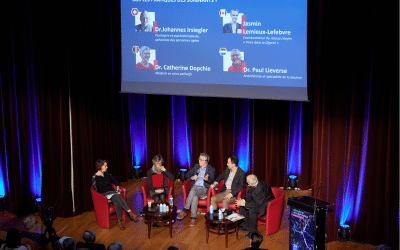Since September 2016, when « New Scientist » published the report of the birth of the first genetically modified baby via “3-parent IVF”, the media has given widespread coverage of this event. Using a controversial “three-parent baby” technique, an in-vitro embryo was conceived using two ovules and a spermatozoid.
Dr. John Zhang and his team at the New Hope Fertility Center in New York City performed this unprecedented transgression. Zhang went to a laboratory in Mexico in utmost secrecy to create this baby requested by a Jordanian couple (thereby evading stricter regulations governing human-embryo modification since the rules in that country are less stringent.)
The purported objective cited by those who promote this technique, has always been to avoid transmitting maternal mitochondrial disease (tiny organelles present in the ovule). This same objective was also cited during the debates in the United Kingdom and in spite of numerous warnings it was finally legalized in 2015. The safety of this technique for the unborn baby has yet to be proven.
At the American Society for Reproductive Medicine’s annual meeting on October 19, 2016 in Salt Lake City, Dr Zhang, who had previously reported the child to be in good health, eventually admitted that this is not the case. Non-negligible quantities of defective mitochondria were transmitted in the first embryonic cell, and thus are present in each and every cell of the young boy. In what way, if any, will this impact his health in the future? Dr Zhang has promised to perform a thorough medical exam of the child and to verify if the level of defective mitochondria remains stable.
For numerous scientists, this technique raises serious concerns regarding efficacy and safety. In the end, the compassionate motive to avoid transmitting this rare disease to children may just be an alibi to continue research on this technique. Apparently there are other motives. The assumption is: using a “young” ovule to incorporate the genetic material of certain women, especially those who have difficulty becoming pregnant due to their advanced age, would improve in-vitro embryo survival or their growth.
In a video published in February 2016 Dr John Zhang advocated using the technique for treating infertility, only briefly mentioning its potential for eliminating the transmission of mitochondrial disease. An article published in October 2016 revealed that apparently he has already attempted to use this technique in China in 2003. Three treated embryos were implanted, and the pregnancy had started but none of the fetuses survived. One was aborted by embryonic reduction after 33 days. The other two had membrane ruptures at 24 and 29 weeks respectively.
In Ukraine two women are pregnant with fetuses created with DNA from 3 people by Dr Valery Zukin from the Nadiya Clinique in Kiev, using the same technique. Since the mothers were not carriers of the disease, these babies were not conceived to prevent the mothers from passing on harmful genes to children through their mitochondria. In these cases the 3-parent IVF technique was used solely to overcome the parents’ infertility.
One woman, who has now reached 28 weeks of pregnancy, is expecting a baby girl, thus the gene editing performed to create this little girl will also affect her gametes, and be transmissible to future generations. The other woman has reached 22 weeks of pregnancy with a male fetus.
Dr Zukin’s team used a technique called pro-nuclear transfer involving two eggs – one from the mother and one from the donor which have both been fertilized by the father’s sperm. Then they extract the ‘pro-nucleus’ from the mother’s egg – that is the core of the cell that contains the mother’s and father’s chromosomes that forms after fertilization. Next they extract the pro-nucleus from the donor’s egg. The donor’s pronucleus is discarded, and replaced with the parents’ pronucleus. It means the newly created embryo gets all its nuclear DNA from its mother and father. The theory is that the cytoplasm (the content of the donor’s egg) is likely to be stronger, healthier and more resilient, thus improving the embryo’s chances for growth or survival.
Dr Dean Betts of Western University in Canada declares: ‘It does not mean that the underlying reasons why the growth of the embryos of these couples stopped in the first place, and we cannot assert that these underlying reasons have disappeared. Perhaps there was something which prevented the development of abnormal embryos. But I think it’s too risky. Further research is needed and I highly recommend banning this procedure in humans as long as we do not know more to ensure its safe use.’
We have gone beyond the purported therapeutic motive of preventing the transmission of rare genetic diseases. It now appears that the “fertility business” is being targeted.
_______
>> For further information on the technique and the ethical questions raised by this issue, please refer to Alliance VITA’s Expert Notes.



